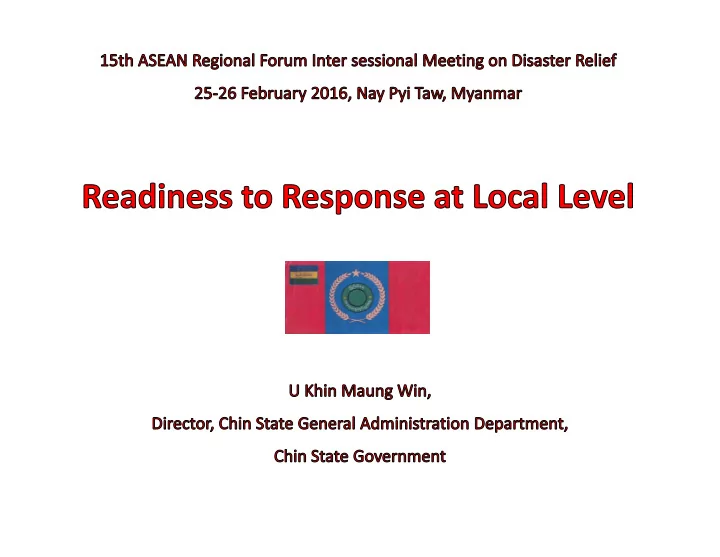

Myanmar
Summary of the disaster • Myanmar is prone to various natural hazards , potentially impacting large numbers of people • Cyclone Komen caused heavy rains • Floods and landslides in several parts of Myanmar • The President declared Chin and Rakhine, Magway, Sagaing natural disaster zones • Over 1.6 people displaced in July ‐ August, 117 casualties • 453,000 houses damaged/destroyed and more than 1.4 million acres of farmlands inundated • US$127 million in direct economic losses .
Chin State • Located in the western of the country • Chin is the poorest state/region in country • A mountainous region with limited transport infrastructure • A population of about 478,690 and density of 13 habitants per square kilometre. • Hakha is the capital city of Chin • Three districts; Phalem, Hakha and Mindat and 9 township • Prone to natural disasters especially landslide.
2015 Floods and Landslides Impacts on Chin State • A high number of landslides caused significant damage with longer ‐ term impacts • Widespread damage to infrastructure with approximately 100 villages reporting damaged to roads • Main road connecting Chin capital to the rest of the country inaccessible during a week • Limited access to townships and markets • Limited access challenges infrastructure rehabilitation in remote areas • Significant livelihood impacts for people living in affected villages, including aggravating food shortages already common in rural Chin
Damages and Losses in Chin State Damaged amount in MMK 1000.000 800.000 Hakha 600.000 Mindat Phalam 400.000 Tongzang Palatwa 200.000 Kanpalat Tedim 0.000 Damage and Loss (in number) Chin State 1800 1600 1400 1200 Hakha Impacts (in Number) 1000 Mindat 5467.89 6000 800 Phalam 5000 600 4000 Tongzang 2979 3000 2157 400 Palatwa 2000 200 1000 Kanpalat 47 172 5 Impacts (in Number) 0 0 Tedim
Relief/Response • Alert on Landslides Immediate • Timely Evacuation • Set up Evacuation Sites/Camps actions • Immediate humanitarian assistances, (food, water, etc.) • Food and NFI provided by local authority, RRD • Multi ‐ sectoral Initial Rapid Needs Assessment led by UNICEF • Humanitarian assistance from UN Agencies, International and Myanmar Relief NGOs and CBO assistance • Temporary learning space to reduce educational gaps • Psychosocial and Protection support • CCCM Assistance (Training, support) • Coordination among the different actors through government led General Coordination Meeting Support • Temporary relocation of affected communities to more suitable places • Support humanitarian assistances to affected population Functions • Information sharing through meeting s or bi ‐ lateral consultations for efficient response
Recovery/Reconstruction • National Disaster Management Committee ‐ Response Plan • Post Disaster Needs Assessment for Developing Recovery Plan • National Level Recovery Plan • Inter ‐ departmental coordination for effective recovery : “Build Back Better” • Assessment for resettlement area by geologists • Collaboration with Private Sector such as Daw Khin Kyi Foundation for resettlement
Chin State Relocation Figures (in MMK Million) 398.04 Construction of Houses Agricultural land Livestocks 434.49 Fish/Shrimp Pond Livelihood 1834.256 Farm garden 60.51 1.41 Social Provision 89.37 46.76 Food Assistance 0.15 Relief Assistance 164.037
Relocation • Housing : (2951) houses have to be reconstructed which were destroyed, damaged and risky houses. • (1623) are accomplished and the remaining (1328) are on ‐ going. • Union Ministry of Environmental Conservation and Forestry and Chin State Government are constructing the houses with the contributions from National Disaster Management Committee (NDMC), National Planning on Natural Disaster Prevention Central, Private Company, World Vision, private donors and others.
Relocation • Cash Assistance: Township Destroyed Damaged Assistance Houses Houses (MMK Million) Hakha 118 0 17.7 Phalam 8 104 3.8 Tedim 67 329 18.275 Tongzang 92 271 20.575 Mindat 36 96 7.8 Kanpalat 30 9 4.725 Palatwa 362 588 69.0 Total 713 1397 141.875 • Electricity : provided by State Electrical Engineer Office for the new resettlement area (new town) • Water Supply : ongoing by Department of Development Affairs
Lessons learnt and good practices in 2015 Flood Disaster • No casualties due to timely warning and early action • Coordination mechanism between National Disaster Management Committee and Regional Body • Effective Operational Coordination among the different actors • Knowledge on natural resource management – moving/shifting hillside cultivation (Taungyar) to terrace cultivation, hunting, set ‐ fire for hillside cultivation • Importance of preparedness to manage impact of climate change, organization and readiness of response/rescue teams, prepositioning for immediate relief assistance. • Improvement of public infrastructure – road accessibility • Need for public awareness
Recommendations for the Readiness to Response (1) • Ultimate goal : Myanmar to become Resilient community • Strengthening/building capacities Public awareness o Training o Drill/Simulation Exercise o • State Disaster Response Plan/ Contingency Plan o Early Warning and Early Action System o Evacuation arrangements (assembly area, evacuation routes, places, etc) o Stocks of humanitarian relief items available in the State o Contacts of key humanitarian actors available and broadly shared o Strategy/arrangements for Communions with affected Communities o Coordination arrangements between local government, humanitarian organizations and civil society
Recommendations for the Readiness to Response (2) • Resources to be available o Financial o Human o Materials • Linking with medium and longer term activities : Risk Mapping and developing Risk Reduction Plan, Structural and non ‐ structural mitigation measures • Coordination, collaboration and cooperation with ALL possible actors for implementing the recommendations for better prepared to responses
Recommend
More recommend